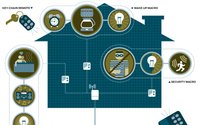Commentary
Smart Home Products Moving To 50% Of Households By 2020
- by Chuck Martin , Staff Writer, May 4, 2016
 Some homes will be getting
smart and others won’t.
Some homes will be getting
smart and others won’t.
The latest forecast of North American broadband households shows that half of them will be smart homes within four years.
Of course, this means that the other half will remain not so smart.
Most (84%) of U.S. households will have broadband this year, so this pretty well translates to most homes, according to the new data from Parks Associates.
Just a day ago, the same researchers identified that many consumers want to be able to connect the smart objects in their homes to their cars, as I wrote about here (Consumers Want Their Home And Car Connected To Each Other). But again, some, not all.
Connected home systems ultimately can incorporate devices such as wearables, smart thermostats, home security, apps and various mobile devices.
But the key is the broadband connection, through which many of the devices communicate to each other and to consumers.
Ownership of smart home products increased from 16% to 19% of U.S. broadband households in the last year and 44% of households that do not have a smart home device plan to purchase one this year.
This growth will continue and 50% of North American households with broadband will be smart homes by 2020, according to the study.
Major companies, including Amazon, Apple, Google and Facebook, are active in connected homes, since they all have a vested interest in creating smart products that might appeal to consumers.
For example, Amazon’s Echo, with its Alexa natural language processing, has been teaming with many other companies that want to be enabled through Amazon’s technology, creating more of a bond with consumers.
The marketing challenge will be to keep up with messaging methods to smart homes and homes that aren’t.
And then there’s the issue of which devices will be more marketing adaptable, since some will have screens through which video communications can be sent while others will be more audio oriented, requiring a different form of messaging.
It appears there will be a divide between the number of consumers who gravitate to smart devices and those who don’t.
Kind of reminds me of the early days of smartphones.




The key to the adoption of smart home technology is understanding the connectivity. Too many people (most early adopters) who got into the space early have had issues due to connectivity. No one informed them not all devices talk to each other. And now through in the security challenges, manufacturers have to do a better job of communicating how secure are their products and what other deivces do their products connect to in the home, car and wearable. Then we will see the market explode.
Well said, Mark. Connectivity issues are a major stumbling block at the moment, at least for those who want to interconnect multiple objects.